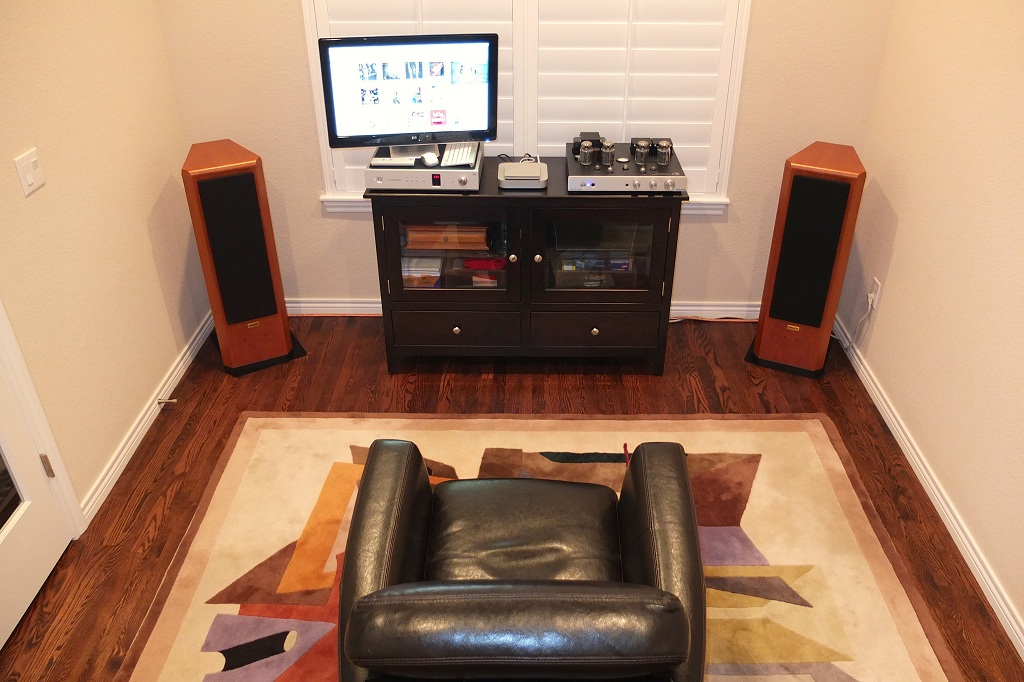Speaker placement in a square listening room by george cardas. The speakers are compact, just 7.9x13.
Small Listening Room Setup, Appropriate for small annual general meetings, conferences and workshops. With all of that in mind, here are some characteristics of a potential listening room:

The thing to keep in mind when positioning your speakers is that you need to find the spot that sounds best in your room. 2) beats (irregularities) in the decay characteristics must be negligible. Fortuitously, the only reasonable way to set up the speakers in our living room is on the 45° diagonal, flanking our fireplace: If you have the misfortune to have a square listening room, as in the previous setup (diagram f), create golden rectangles in the rear corners of the room.
It usually will provide little to no help with low frequency room issues.
It usually will provide little to no help with low frequency room issues. If you’re in a particularly small room (say, a bedroom), aim for 0.1 to 0.3 seconds. The most accurate control rooms are highly damped with reverberation times less than about 0.3 seconds. Space for audio equipment, a chair, and any accessories. I am considering using a small home office as a dedicated listening room. 2) beats (irregularities) in the decay characteristics must be negligible.
 Source: audiokarma.org
Source: audiokarma.org
The smaller the room, the shorter the decay times should be. Small rooms will have a listening position of 45.8%, medium length rooms will be. This is great for determining the sound quality for one tube. What you want to do is sit at your desk with your head in your new magical mix position and then draw two imaginary.
 Source: canuckaudiomart.com
Source: canuckaudiomart.com
Small rooms will have a listening position of 45.8%, medium length rooms will be. With all of that in mind, here are some characteristics of a potential listening room: Space for audio equipment, a chair, and any accessories. In a recent aes paper titled: Inaccurate positioning can result in all the problems listed above plus quite a few more.
 Source: pinterest.com
Source: pinterest.com
Four (or more) walls that separate it from other areas. This results in each angle being 60 degrees each. I am considering using a small home office as a dedicated listening room. Make sure the listening position isn’t in a bass null, like in the middle of the room, or in a buildup area like all the way back on.
 Source: pinterest.com
Source: pinterest.com
Look at the lowest wave like that the speaker produces, we need to have distance to allow for that wave to fit into the room dimensions. There’s no way a listening position of 37.5% will work in a small length room. Inaccurate positioning can result in all the problems listed above plus quite a few more. This would allow me.
 Source: pinterest.com
Source: pinterest.com
Four (or more) walls that separate it from other areas. The practical effects of lateral energy in critical listening environments authored by richard king, brett leonard and grzegorz sikora, controlled listening tests were conducted in small rooms with a panel of 26 professional recording and mixing engineers, editors and producers, and students of sound recording. If you’re in a particularly.
 Source: joystudiodesign.com
Source: joystudiodesign.com
In other words, a guest bedroom might work fine. The larger the room, the more the issue shifts to reverberation time or reflections. The practical effects of lateral energy in critical listening environments authored by richard king, brett leonard and grzegorz sikora, controlled listening tests were conducted in small rooms with a panel of 26 professional recording and mixing engineers,.
 Source: apppie.org
Source: apppie.org
The next step up is to use 2×6 plate with 2×4 studs that are staggered. For a nominal additional cost you can use 5/8″ type x sheetrock on the wall outside the listening room. I could clear out the room and have it dedicated to gear only (and a chair or two and cd racks). It usually will provide little.
 Source: joystudiodesign.com
Source: joystudiodesign.com
What you want to do is sit at your desk with your head in your new magical mix position and then draw two imaginary lines coming off the back of your head that pass through your ears. Unlike the u style, this style includes seats on all sides of the table/s. Look at the lowest wave like that the speaker.
 Source: pinterest.fr
Source: pinterest.fr
Speaker placement in a square listening room by george cardas. This results in each angle being 60 degrees each. Appropriate for small annual general meetings, conferences and workshops. There’s no way a listening position of 37.5% will work in a small length room. I could clear out the room and have it dedicated to gear only (and a chair or.
 Source: br.pinterest.com
Source: br.pinterest.com
The rules are a much looser for listening rooms, says craig abplanalp, vice president of definitive audio, a custom a/v design and installation firm in seattle and bellevue, wash. I could clear out the room and have it dedicated to gear only (and a chair or two and cd racks). Unlike the u style, this style includes seats on all.
 Source: reddit.com
Source: reddit.com
They should be pointing 30 degrees to the right and left of your nose. Small rooms will have a listening position of 45.8%, medium length rooms will be. The larger the room, the more the issue shifts to reverberation time or reflections. This costs next to nothing, but increases the stc rating. There’s no way a listening position of 37.5%.
 Source: pinterest.com
Source: pinterest.com
This results in each angle being 60 degrees each. Four (or more) walls that separate it from other areas. The larger the room, the more the issue shifts to reverberation time or reflections. Then move your speakers an inch or two in a different direction and test the sound from that distance. 3) decays must be perfectly exponentialproduce straight lines.
 Source: pinterest.co.uk
Source: pinterest.co.uk
A rectangular or an oval table is appropriate for this kind of a setup. The company was founded in 1949, and is known for crafting some of the finest home audio systems to deliver an unparalleled listening experience. The best way to get great sound quality in a small room. The result is four setups worthy of even the most.
 Source: pinterest.com
Source: pinterest.com
Closer spacing and lower crossover frequencies will typically allow the wavefront to coalesce at shorter listening distances. The thing to keep in mind when positioning your speakers is that you need to find the spot that sounds best in your room. Make sure the listening position isn’t in a bass null, like in the middle of the room, or in.
 Source: pinterest.com
Source: pinterest.com
In a recent aes paper titled: The most accurate control rooms are highly damped with reverberation times less than about 0.3 seconds. It�s in a basement has a concrete floor with parquet glued to it, concrete ceiling, 2 adjacent walls are also reinforced concrete and the other 2 are plasterboard walls.my 2 seater listening sofa is about 3/4 of the.
 Source: audioasylum.com
Source: audioasylum.com
In a recent aes paper titled: The company was founded in 1949, and is known for crafting some of the finest home audio systems to deliver an unparalleled listening experience. The result is four setups worthy of even the most discerning audiophiles� ears. With all of that in mind, here are some characteristics of a potential listening room: The speakers.
 Source: audiokarma.org
Source: audiokarma.org
For a nominal additional cost you can use 5/8″ type x sheetrock on the wall outside the listening room. Time has come to sort out my small room with a decent hifi setup. Make sure the listening position isn’t in a bass null, like in the middle of the room, or in a buildup area like all the way back.
 Source: reddit.com
Source: reddit.com
The best way to get great sound quality in a small room. Then move your speakers an inch or two in a different direction and test the sound from that distance. I could clear out the room and have it dedicated to gear only (and a chair or two and cd racks). Closer spacing and lower crossover frequencies will typically.
 Source: pinterest.pt
Source: pinterest.pt
They should be pointing 30 degrees to the right and left of your nose. The company was founded in 1949, and is known for crafting some of the finest home audio systems to deliver an unparalleled listening experience. The smaller the room, the larger the low frequency pressure issue is. It usually will provide little to no help with low.
 Source: pinterest.de
Source: pinterest.de
In other words, a guest bedroom might work fine. Fortuitously, the only reasonable way to set up the speakers in our living room is on the 45° diagonal, flanking our fireplace: If you have the misfortune to have a square listening room, as in the previous setup (diagram f), create golden rectangles in the rear corners of the room. See.
 Source: pinterest.com.mx
Source: pinterest.com.mx
Four (or more) walls that separate it from other areas. 1) there can be no frequency or spatial irregularities. This results in each angle being 60 degrees each. There’s no way a listening position of 37.5% will work in a small length room. 3) decays must be perfectly exponentialproduce straight lines on a logarithmic scale.
 Source: pinterest.co.uk
Source: pinterest.co.uk
First of all, the layout and the table setup of a meeting room are as important as the venue itself. The best way to get great sound quality in a small room. If you have the misfortune to have a square listening room, as in the previous setup (diagram f), create golden rectangles in the rear corners of the room..
 Source: pinterest.co.uk
Source: pinterest.co.uk
Inaccurate positioning can result in all the problems listed above plus quite a few more. Similarly, the second harmonic of 40 hz (80 hz) will exhibit a null at the point one quarter of the distance from the back wall. One of the most common issues we address in room setup is the issue of positioning, and if it’s done.
 Source: pinterest.com
Source: pinterest.com
The smaller the room, the larger the low frequency pressure issue is. For a nominal additional cost you can use 5/8″ type x sheetrock on the wall outside the listening room. The most accurate control rooms are highly damped with reverberation times less than about 0.3 seconds. 1) there can be no frequency or spatial irregularities. The next step up.
 Source: stereophile.com
Source: stereophile.com
Space for audio equipment, a chair, and any accessories. This is great for determining the sound quality for one tube. Closer spacing and lower crossover frequencies will typically allow the wavefront to coalesce at shorter listening distances. The practical effects of lateral energy in critical listening environments authored by richard king, brett leonard and grzegorz sikora, controlled listening tests were.










